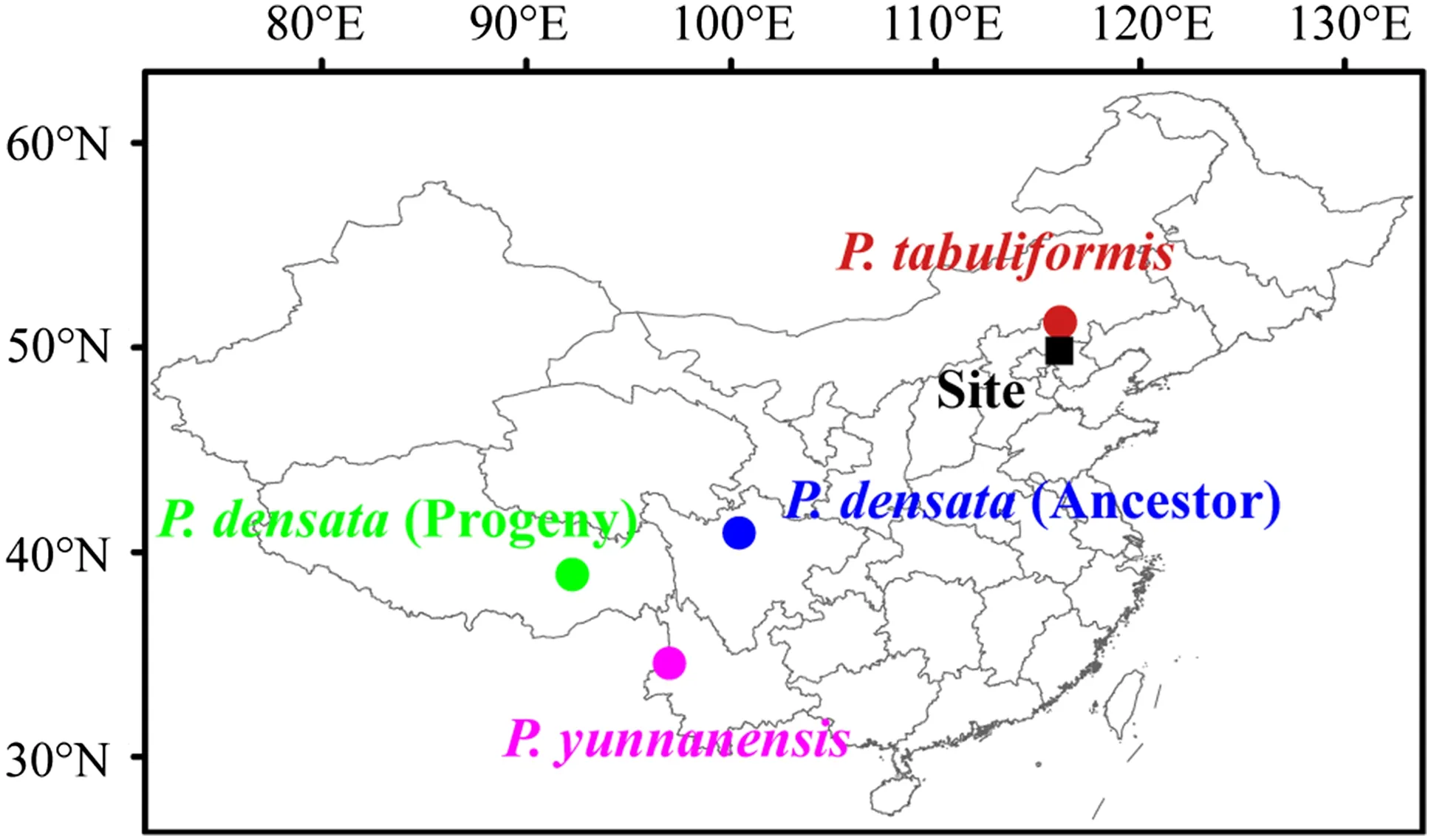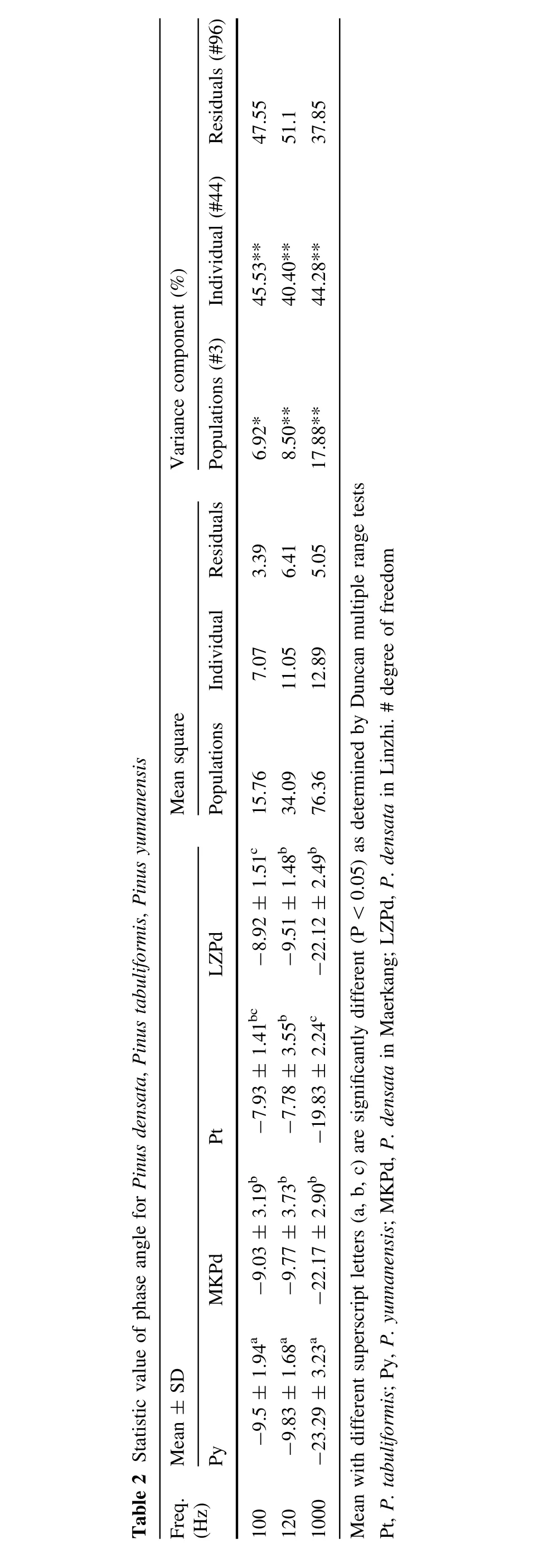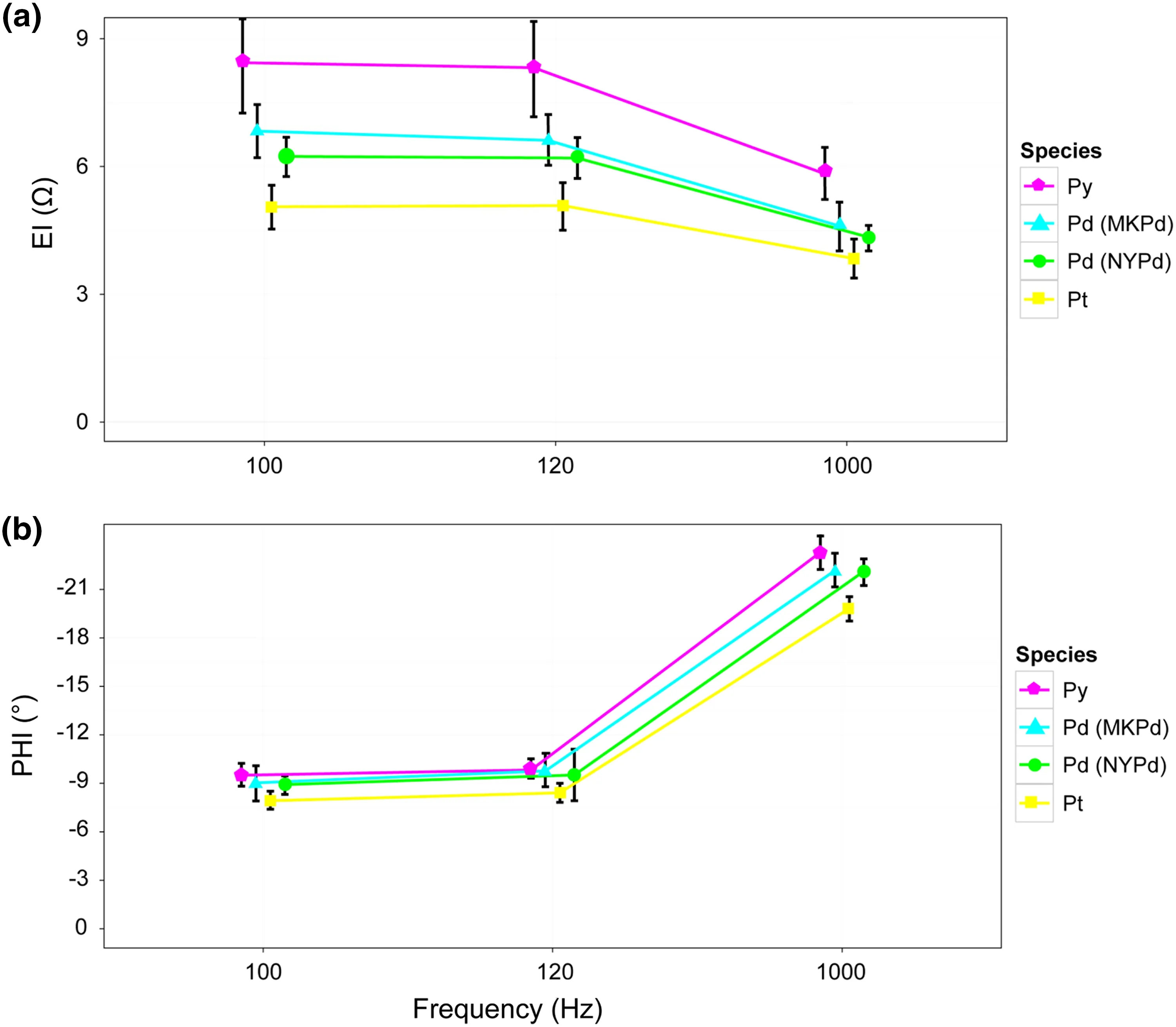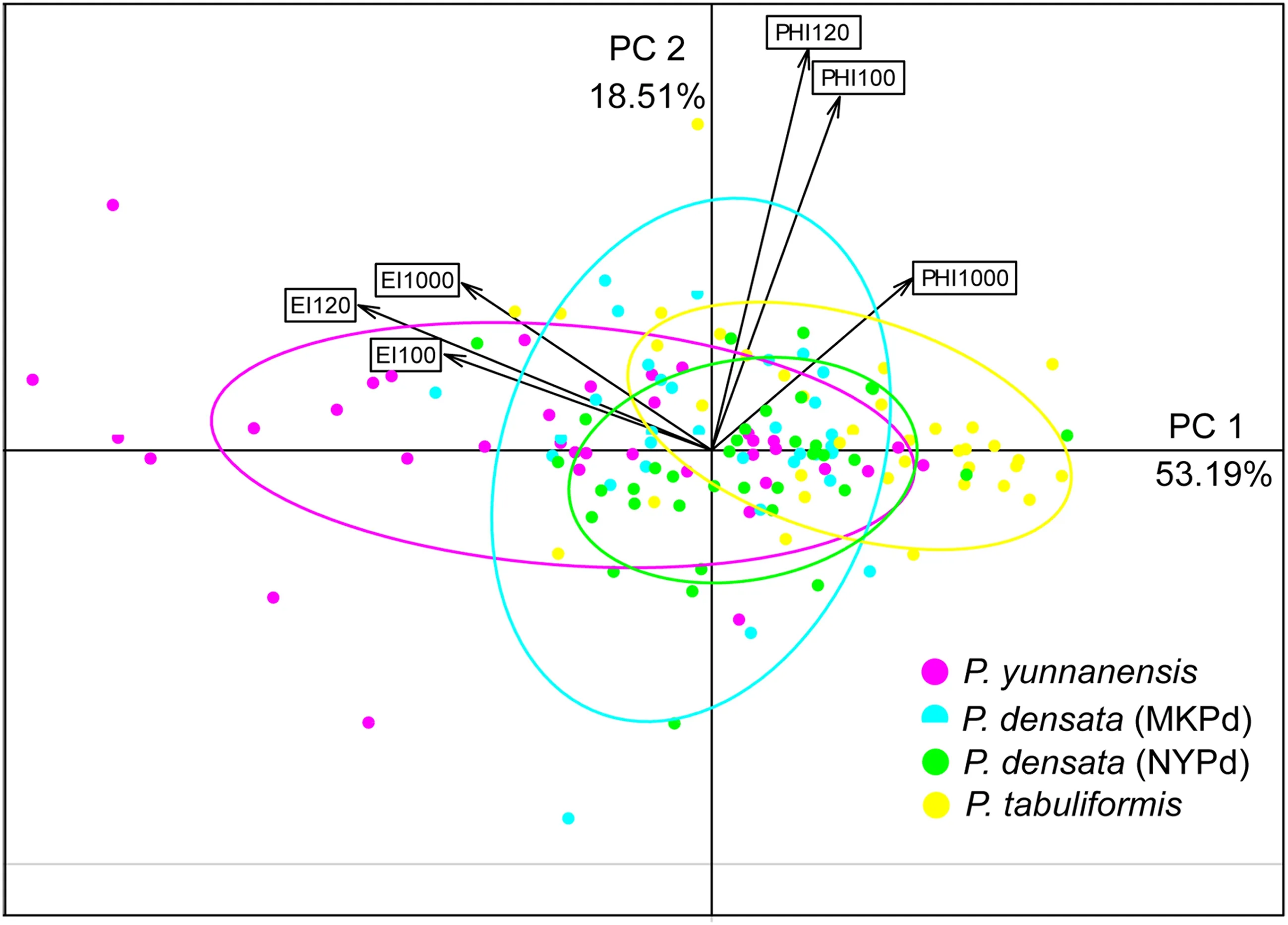Variations in electrical impedance and phase angle among seedlings of Pinus densata and parental species in Pinus tabuliformis habitat environment
2015-06-05XinyuChenHuweiYuanXiangeHuJingxiangMengXianqingZhouXiaoRuWangYueLi
Xinyu Chen•Huwei Yuan•Xiange Hu•Jingxiang Meng•Xianqing Zhou•Xiao-Ru Wang,2•Yue Li
Variations in electrical impedance and phase angle among seedlings of Pinus densata and parental species in Pinus tabuliformis habitat environment
Xinyu Chen1•Huwei Yuan1•Xiange Hu1•Jingxiang Meng1•Xianqing Zhou3•Xiao-Ru Wang1,2•Yue Li1
Electricalimpedance(EI)and phase angle(PHI) parameters in AC impedance spectroscopy are important electrical parameters in the study of medical pathology. However,little is known abouttheirapplication in variation and genetic relationship studies of forest trees.In order to testwhetherimpedance parameters could be used in genetic relationship analysis among conifer species,EI and PHI were measured in a seedling experiment test composed of Pinus tabuliformi s,Pinus yunnanensis,and Pinus densata in a habitat of Pinus tabuliformi s.The results showed that variations in both EI and PHI among species were significantin differentelectric frequencies,and the EIand PHI values measured in the two populations of P.densata were between the two parental species,P.yunnanensis and P. tabuliformis.These results show that these two impedance parameters could reflectthe genetic relationship among pine species.This was the firsttime using the two AC impedance spectroscopy parameters to test the genetic relationship analysis between tree species,and would be a hopefulnovelreference methodology for future studies in evolution and genetic variation of tree species.
Electrical impedance·Phase angle·Pinus tabuliformi s·Pinus yunnanensis·Pinus densata·Seedling needle·Genetic variation
Introduction
Electrical impedance spectroscopy(EIS)has been used to representthe equivalentcircuitof a tissue sample in studies of medicalpathology and other research fields(Zhang etal. 2005).Electricalimpedance(EI)and phase angle(PHI)are important electrical parameters in AC impedance spectroscopy.In physics,EI is an electrical property reducing the currentthrough the object,while PHIis an arc tangent of the reactance to resistance ratio multiplied by a constant to convert radians to degrees(Cseresnye´s et al.2013).
In biophysics,EIand PHIare determined by organizational characteristics of extracellular space,cells conductivity and AC frequency.Both the parameters can reflectthe biological featuresin tissue,organ,cell(Luo etal.2005)and representthe statusofplantdevelopment.EIS isofgreatimportance to food processing and food industry and medicalpathology(Gao etal. 2012)due to severaladvantages:no damage to samples,operationalsimplicity,and low cost(Zhang etal.2005).
Indices of intracellular and extracellular resistance,relaxation time,and distribution coefficientof the relaxation time spectrum have been used for estimating tree vigor(Mac-Dougalletal.1987),degree offruitdamage(Cox etal.1993), cold hardiness(Repo etal.2000;Lietal.2008;Zhang etal. 2009),heatresistance(Hao etal.2010;Liu etal.2012),salt tolerance(Yao etal.2011),and droughtresistance(Liu etal. 2007a,b).However,thereisno reporton application ofEIandPHIin a genetic study of pine species.Under identicalexperimental conditions,EI and PHI measurements in relative pine species could reveal their effectiveness in genetic variation and relationship studies among trees species and provide a new reference method forfuture forestgenetic studies.
The evidence from anatomy analysis and molecular genetics analysis shows that Pinus densata originates from a natural hybrid between Pinus tabuliformis(Pt)and Pinus yunnanensis(Py)and occupies an importantposition in the evolution research ofthe hybrid origin oftrees(Wang etal. 2001;Song etal.2003;Cai etal.2006).Maerkang(MKPd) and Linzhi(LZPd)represent the original area and typically presenthabitatof P.densata,respectively(Wang etal.2011). In thisstudy,we aimed to examine:(1)ifthere are significant differences in the impedance parameters among studied pine species;(2)whether impedance parameters could reflectthe genetic relationship of P.densata and parentalspecies;(3)if they could be used to identify the evolution process between populations of P.densata;and(4)if P.densata could develop in the habitatof parentalspecies.The results obtained would provide a new empirical method for further biophysical genetic variation researches in plant.
Materials and methods
Study site
The seedling test was conducted in Pingquan,Hebei Province(118.45°E,40°N;526 m a.s.l.),which is a habitat of P.tabuliformis.Pingquan is in semi-humid continental monsoon climate zone,with annual precipitation of about 520–540 mm,average temperature of 7.3°C,and frostfree period of 115–150 days.
Species and populations
Samples of P.tabuliformis and P.yunnanensis were mixed with open-pollinated seeds from the largestnaturalstands in Ningcheng,Inner Mongolia,and Gongshan,Yunnan Province,respectively.The two sample populations of P.densata were in Maerkang,Sichuan Province and Linzhi,Tibet. The seed samplesforeach population were mixed seedsfrom 30 randomly selected trees within the main naturalstand of each sampling region.The geographic locations of the sample populationsofeach species were presented in Fig.1.
Field design
In the field,we designed a randomized complete block (RCB)with four replications.Within each block,each species constituted a single 60-tree plot.Planting spaces and seedling management were common in all plots.

Fig.1 Test sites and geographic locations of sample populations of each species(MKPd,P.densata in Maerkang;LZPd,P.densata in Linzhi.)
Measurement of impedance parameters
Three-year-old seedlings were used for the impedance parameters evaluation.They were measured on May 8–15, 2014.Twelve seedlings with normalgrowth in each species (population)were randomly selected as samples.Three normal growth needles of each plant were randomly selected on middle regions of the seedling crown.Position of measurement for each needle was on the middle section of 1 cm in length.A totalof 144 needles in 48 seedlings were measured in four species(populations).
The measurement instrument for impedance parameters was a Handheld LCR Meter(manufactured by My Dream Electronic InstrumentCo.,Ltd.China).The EIand PHIcould be directly recorded by the instrument.Three current frequencies,100,120,and 1000 Hz,were chosen fordrawing the change curves of impedance parameters(Zhang etal.2005).
Statistical analysis
Meansand standard deviationsforeach impedance parameter among pine species were estimated.Analyses of variance (ANOVAs)of each impedance parameter among the pine species were analyzed using a nested linear model(individuals within species and populations)and variance components were estimated.The significance of differences among the pine species was examined using Duncan’s multiple range test.Statistics were performed with R software.
Results
Differences in impedance parameters among species (populations)
EI and PHI showed significant differences among P. tabuliformis,P.yunnanensis,and P.densata in Maerkang;in Linzhi,the results were estimated in alltestfrequencies (Tables 1 and 2),which means that both EI and PHI could be effectively used for describing the electrical characteristics of impedance in pine species.
Variance analysis of EI for each current frequency showed thatmore than 20%of the variance components among the species were counted in all frequencies,and almost 50%of the variance components among individuals were counted(Table 1).Variance analysis of PHI for each current frequency showed that more than 6%of variance components among species were counted in all frequencies,and almost 40%of the variance components among individuals were counted (Table 2).This means that variations among species were lower and differences among individuals were the major sources of variation in terms of the impedance parameters.The curves of EIin pine species showed that EI decreased with an increase of current frequency (Fig.2a).While the curves of PHI had the opposite trend,that PHI increased with increase of current frequency(Fig.2b).
According to the principal component analysis (Fig.3),P.tabuliformis showed a broad distribution that partly overlapped with P.yunnanensis.Both populations of P.densata were intermediate with parental species.In addition,P.densata in Maerkang showed a broad distribution that almost covered the range of P.densata in Linzhi.
Differences in impedance parameters between P. densata and parental species
Comparison ofthe impedance parameters in P.densata,P. tabuliformis,P.yunnanensis showed that the impedance parameters foralltested frequencies were the highestin P. yunnanensis and lowest in P.tabuliformis,which means that there was stronger genetic variation of the electrical impedance spectrum feature among the pine species (Fig.2).EI and PHI were in the intermediate position and consistent for P.densata,which suggested that the EI and PHI could reflect the genetic relationship among pine species to a certain extent(Fig.2).
Comparison of impedance parameters of P.densata in Maerkang and Linzhi
The EI and estimated standard deviations of P.densata in Maerkang in all tested voltage frequencies were relatively higher than that in Linzhi(Table 1),meaning that less significant variations of EI existed between individuals within P.densata in Linzhi.However,PHI was contradictory to EI(Table 2).


Discussion
Significant differences in two impedance parameters among studied pine species(populations)
Significantdifferencesin thetwo impedanceparameterswere found among P.tabuliformis,P.yunnanensis,and P.densata in Maerkang and Linzhi.Significant differences in EI were observed among cultivars in Malus pumila as well(Guo etal. 2006;Chen etal.2008;Du etal.2013a),suggesting thatsome characteristic biology variations existed in the pine species. Impedance parameters including impedance,inductance,and capacitance were created by the response ofbiologicaltissue to changes in the interference electric(Zhou etal.2009;Du etal.2013b).Also,they mightbe affected by complex biological electricity changes in different cell structures and varying activities ofthe same structure.Differentimpedance parameters among species might be brought about by the combined effect of the factors.Researchers found that PHI could reflect the physiological and biochemical changes in plant tissues in Betula platyphylla(Meng et al.2013).The genetic variation among populations within species,as wellas genotype by environment interaction in impedance parameters should be considered in further studies.
Impedance parameters for the genetic relationship of P.densata and parental species
PHIisinfluenced by age-dependentcharacteristic changesin plant tissue(Cseresnye´s et al.2013),though we have adapted,using annualneedles and measured underthe same test conditions,to avoid this problem.In our studies,significant differences in EI and PHI between P.yunnanensis and P.tabuliformis reflected the obvious genetic differences between parentalspecies.The values of EIand PHIbetween P.densata and the parental species revealed the hybrid characters of P.densata,and provided evidence for the hypothesisthatimpedance spectroscopy mightbe a biophysical phenotype that can reflect structural and cytogenetic characteristics of a species.The genetic relationship between P. densata and parental species revealed by impedance parameters meant that the cytogenetic characteristics were relatively stable during four million years of evolutionary process on a rising high plateau for P.densata after initial hybridization(Wang etal.2011;Gao etal.2012).
Impedance parameters for identification of the evolution process between populations of P.densata

Fig.2 Electrical impedance (EI)and phase angle(PHI) comparison for Pinus densata, Pinus tabuliformis,Pinus yunnanensis

Fig.3 Principal component analysis of Pinus densata,Pinus tabuliformis,Pinus yunnanensis
Despite great genetic differences existed between P.densata(in Maerkang and Linzhi)and their theoretical parental populations(P.tabuliformis and P.yunnanesis) (Wang et al.2001;Ma et al.2010),the EI and PHI in P. densata in Maerkang and Linzhiwere stillsimilar and were positioned between the theoretical parental species,showing the relative consistency of both the impedance spectrum parameters and genetic relationship of them with parentalspecies.
P.densata originated from the natural hybridization in the northeast Tibetan Plateau and formed the pure forestin Linzhivalley for mostly four million years(Liu etal.2011;Wang et al.2011).Here,impedance parameters in P. densata in Maerkang were slightly higher than that in Linzhi,meaning that there are some needle tissue and cell structural differences between them.For example,differences between impedance parameters of the ancestral population and the highly developed P.densata of today reflectgenetic variations along the evolutionary processes. Moreover,complex genetic basis in the ancestral population may be also in response to the genetic variation.For example,the impedance parameters in the ancestral population in Maerkang were even more closely to P. yunnanensis than in developed population in Linzhi with complex genetic source demonstrated by molecular genetics(Wang etal.2011;Gao et al.2012).
P.densata for developing in the habitat of parental species
The ability to penetrate the plant organization might be altered when frequencies and electric field strength changed.There are large EI when the current is at low-frequency,with currentonly flowing through the extracellular space.As frequencies increase,capacitance between the membrane and cell wall would increase.High-frequency currentwould break down membrane,passing through the cell.Planttissues mightadjustthemselves to adaptorresist to the damage from the externalenvironment when plants are under adverse stress,leading to EI and PHI changes (Tang and Zhang 2012).
Some populations of P.densata,which originated from the homogenous hybridization,might adapt the parental habitat environment(Liang et al.2013).As a result,the impedance parameters in P.densata in both Maerkang and Linzhi were intermediate between P.tabuliformis(native species with the best adaption)and P.yunnanensis,suggesting median adaptability of this hybrid species in the parentalspecies habitat.Climate factors in P.tabuliformis habitats—such as vapor pressure,mean diurnal range of temperature,accumulative heat,and frost frequency—are different from P.densata habitats and might impact the survival and reproduction of P.densata(Mao et al.2007; Dai et al.2014).P.yunnannesis habitats are clearly different from the transplanted habitats which is dry and has less rainfall.For the changes of hydro-thermalfactors and soil condition,habitat selection may be more remarkable and lead to a change in EI and PHI(Xing etal.2014).
Conclusion
EI and PHI provided a fresh perspective to geneticists for furtherresearches in plant.We checked the EIand PHIin a seedling experiment test composed of P.tabuliformi s,P. yunnanensis,and P.densata in a P.tabuliformi s habitat. Hopefully,significant differences of EI and PHI among P. tabuliformis,P.yunnanensis,and P.densata in Maerkang and Linzhi were observed in all tested current frequencies. Moreover,the two impedance parameters could be used to reflect the genetic relationship among pine species to a certain extent and identify the evolutionary process between populations of P.densata.Although our studies could not reflect the mechanisms of the adaption among species,consistent position of P.densata relative to parentalspecies in impedance spectroscopy mightsuggestthat this method could be used to examine genetic differences and adaptable features among pine species.
Our experiment marked the first time of using the two AC impedance spectroscopy parameters in genetic relationship analysis between tree species,and will hopefully become a novelreference methodology forfuture studies in evolution and genetic variation of tree species.Differences in EI and PHI between P.densata and parental species in our study mightbe impacted by complex factors during the process of speciation.
FundingThis research was funded by the Natural Science Foundation of China(31070591)and Special National Forestry Public Welfare Industry Research(201104022)and the support of Agriculture and Animal Husbandry College of Tibet University.
Cai Q,Zhang D,Liu Z-L,Wang X-R(2006)Chromosomal localization of 5S and 18S rDNA in five species of subgenus Strobus and their implications for genome evolution of Pinus. Ann Bot 97(5):715–722
Chen ZY,Zhang JP,Liu YL,Wang RQ,Wang GD(2008) Relationships between Tomato maturity and dielectric parameters.Acta Bot Boreal Occident Sin 28(4):826–830
Cox MA,Zhang M,Willison J(1993)Apple bruise assessment through electricalimpedance measurements.JHortic Sci(United Kingdom)68(3):393–398
Cseresnye´s I,Rajkai K,Voza´ry E(2013)Role of phase angle measurement in electrical impedance spectroscopy.Int.Agrophys 27:377–383
DaiJF,Meng JX,Mao JF,Zhao W,Liu H,Xing Z,Zhang H,Wang XR, Li Y(2014)Comparison analysis of seedling traits for hybrids between Pinus tabuliformis×P.yunnanensis and its parental species in P.densata habitatsite.JBeijing ForestUniv 36(1):8–14
Du GY,Tang Y,Guo AG,Zhang JP(2013a)Influence of frequency signal on electrical property of peach fruits.J Food Sci 34(7):11–15
Du ZH,Zhu JQ,Wei T,Huang QS,Zhu XX(2013b)Research progress of electrical impedance spectrum technology in the diagnosis of thyroid carcinoma.Chin Base Clin General Surg 20(9):995–1000
Gao J,Wang BS,Mao JF,Ingvarsson P,Zeng QY,Wang XR(2012) Demography and speciation history of the homoploid hybrid pine Pinus densata on the Tibetan Plateau.Mol Ecol 21(19):4811–4827
Guo WC,Guo KQ,Zhu XH(2006)Application of dielectric properties in identifying species of tomatoes and apples.Trans Chin Soc Agric Mach 37(8):130–132
Hao Z,Zhang G,Ya L(2010)Physiological and biochemical indexes and electrical impedance spectroscopy of platyhylla seedings under heatstress.Acta Bot Boreal Occident Sin 30(9):1844–1851
Li YQ,Zhang G,Que SP,Zhu L,Di B,Jin XM(2008)Relation between electrical impedance spectroscopy parameters and frost hardiness in stems and needles of Pinus bungeana.Scientia silvae Sinicae 44(4):28–34
Liang D,Mao JF,Zhao W,Zhou XQ,Yuan HW,Wang LM,Xing FQ,Wang XR,Li Y(2013)Seedling performance of Pinus densata and its parental population in the habitat of P. tabuliformis.Chinese.J Plant Ecol 37(2):150–163
Liu X,Wang G,Zhang G(2007a)The relationship between electrical impedance spectroscopy parameters and physiological parameters of wheat leaves under drought stress.Acta Bot Boreal Occident Sin 27(5):859–863
Liu X,Wang Gd,Zhang G(2007b)Response of wheat leaves to electrical impedance spectroscopy parameters in water stress. J Lanzhou Univ(Natural Sciences)43(5):48–53
Liu YL,Wang XR,Li Y(2011)Geographic isolation between the homoploid hybrid Pinus densata and its parental Pinus yunnanensis.Plant Divers Res 33(3):269–274
Liu YC,Xiao JZ,Yang JS(2012)Effectofhigh temperature stress on electrical impedance spectroscopy parameters of chrysanthemum.J Wuhan Bot Res 30(2):198–203
Luo C-Y,Zhang Z-B,Wang J,He W(2005)Electrical impedance technology applied to examining brain edema.JChongqing Univ 28(2):32–35
Ma F,Zhao C,Milne R,Ji M,Chen L,Liu J(2010)Enhanced drought-tolerance in the homoploid hybrid species Pinus densata:Implication for its habitat divergence from two progenitors. New Phytol 185(1):204–216
MacDougall RG,Thompson R,Piene H(1987)Stem electrical capacitance and resistance measurements as related to totalfoliar biomass of balsam fir trees.Can J Forest Res 17(9):1071–1074
Mao JF,Li Y,Liu YJ,Liu H,Wang XR(2007)Cone and seed characteristics of Pinus densata and their adaptive fitness implications.J Plant Ecol(Chinese Version)31(2):291–299
Meng Y,Di B,Zhang G,Feng XG,Xu CL,Tian J(2013)The correlation analysis of soluble sugar and starch contents with electrical impedance in Betula platyphylla Suk.Roots under waterlogging and flooding stresses.Acta Biophysica Sinica 29(6):450–460
Repo T,Zhang G,Ryyppo¨A,Rikala R(2000)The electrical impedance spectroscopy of Scots Pine(Pinus Sylvestris L.)shoots in relation to cold acclimation.J Exp Bot 51(353):2095–2107
Song BH,Wang XQ,Wang XR,Ding KY,Hong DY(2003) Cytoplasmic composition in Pinus densata and population establishmentof the diploid hybrid pine.Mol Ecol12(11):2995–3001
Tang Y,Zhang JP(2012)Identification of Kiwifruit and peach varieties based on dielectric propert.J Food Sci 33(3):1–4
Wang XR,Szmidt AE,Savolainen O(2001)Genetic composition and diploid hybrid speciation of a high mountain pine,Pinus densata,native to the Tibetan Plateau.Genetics 159(1):337–346
Wang BS,Mao JF,Gao J,Zhao W,Wang XR(2011)Colonization of the Tibetan Plateau by the homoploid hybrid pine Pinus densata. Mol Ecol 20(18):3796–3811
Xing FQ,Mao JF,Meng JX,Dai JF,Zhao W,Liu H,Xing Z,Zhang H,Wang XR,LiY(2014)Needle morphologicalevidence ofthe homoploid hybrid origin of Pinus densata based on analysis of artificialhybrids and the putative parents,Pinus tabuliformis and Pinus yunnanensis.Ecol Evol 4(10):1890–1902
Yao L,Zhang G,Lv W,Deng YC,An ZJ,Zhou J(2011)Changes of electrical impedance spectroscopy parameters and electrolyte leakage in differentornamentaltree species living in saline.Chin Agric Sci Bull 27(6):54–59
Zhang G,Xiao JZ,Chen DF(2005)Electrical impedance spectroscopy method for measuring cold hardiness of plants.J Plant Physiol Mol Biol31(1):19–26
Zhang J,Zhao HJ,Zhang G,Yang MS(2009)Cold hardiness assessment of germplasm resources in Robinia pseudoacacia using electrical impedance spectroscopy.J Plant Genet Res 10(3):419–425
Zhou L,Liu L,Wang L,Liu Q(2009)Bioelectrical impedance technique and the estimation of postmortem interval.In:Wang JX,Chang L(eds)The internationalsymposium on evidence law and forensic science.China University of Political Science and Law Publisher,Beijing,pp 286–295
11 July 2014/Accepted:10 September 2014/Published online:29 April 2015
©Northeast Forestry University and Springer-Verlag Berlin Heidelberg 2015
The online version is available at http://www.springerlink.com
Corresponding editor:Hu Yanbo
✉Yue Li liyue@bjfu.edu.cn
1National Engineering Laboratory for Forest Tree Breeding, Key Laboratory of Genetic and Breeding in Forest Trees and Ornamental Plants of Ministry of Education,College of Biological Sciences and Technology,Beijing Forestry University,Beijing 100083,People’s Republic of China
2Department of Ecology and Environmental Science,Umea˚ University,SE-901 87 Umea˚,Sweden
3State-owned Forest Farm in Hebei Province, Pingquan 067509,Hebei,China
杂志排行
Journal of Forestry Research的其它文章
- Axial variations in anatomical properties and basic density of Eucalypturograndis hybrid(Eucalyptus grandis×E.urophylla) clones
- Nest site characteristics and nest loss of Marsh Grassbird at Zhalong National Nature Reserve,China
- Optimization of corn-stalk skin flake-wood shaving composite technology
- Characterization of ploidy levels in Chrysanthemum L.by flow cytometry
- Effects of salinity on the nail-holding power of dimension lumber used in light-frame wood building
- Spatial distribution of heavy metals(Cu,Pb,Zn,and Cd) in sediments of a coastal wetlands in eastern Fujian,China
